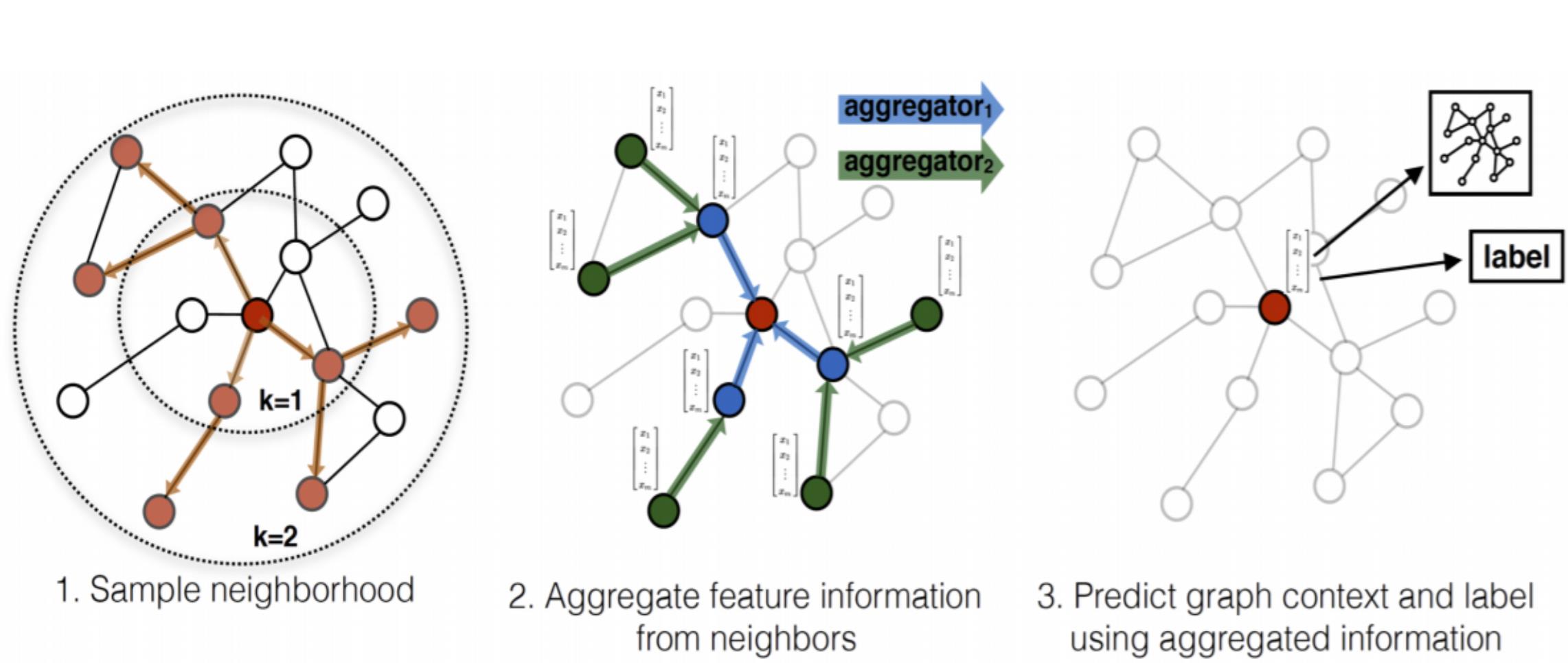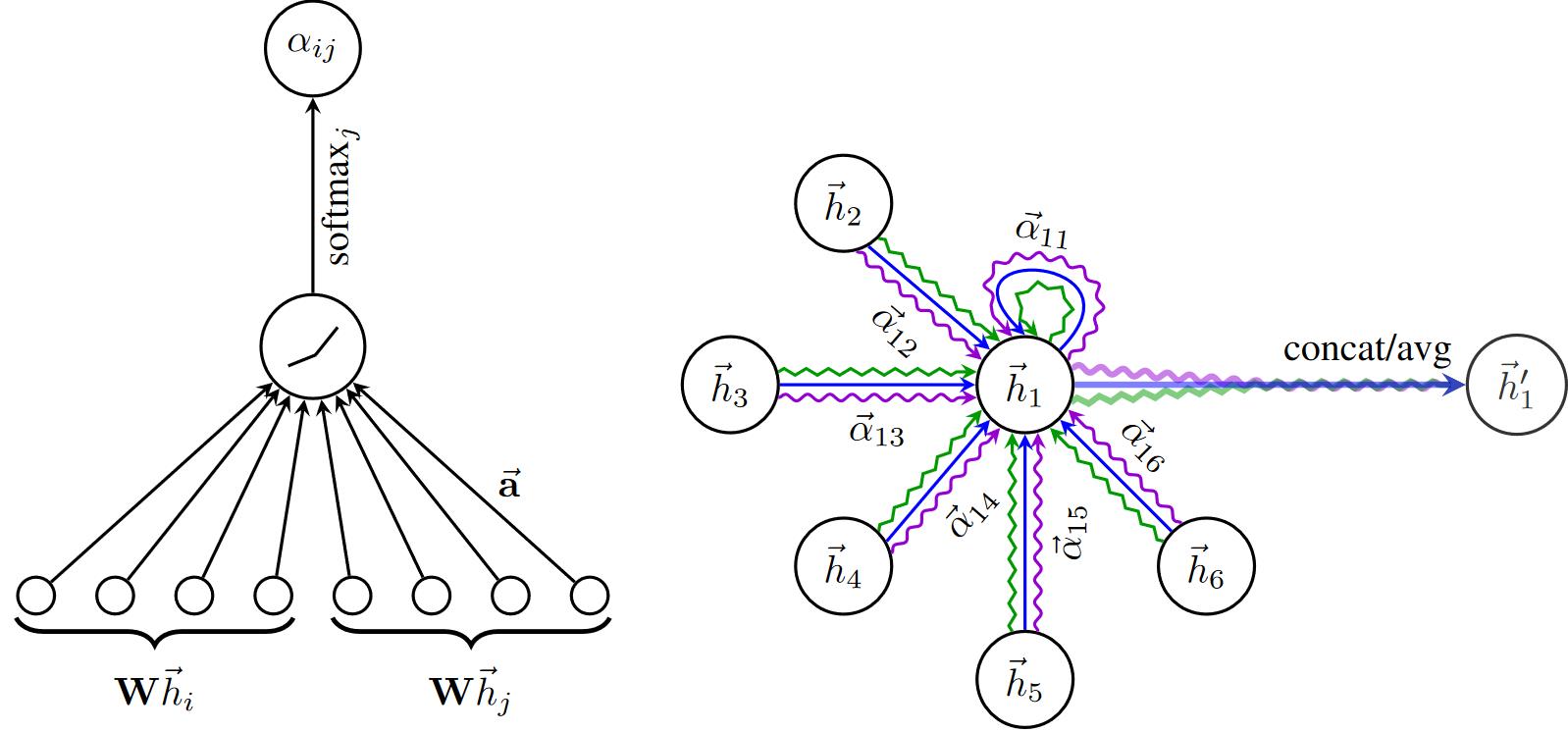Pytorch-geometric: Creating Message Passing Networks 构建消息传递网络教程
Posted LeonYi
tags:
篇首语:本文由小常识网(cha138.com)小编为大家整理,主要介绍了Pytorch-geometric: Creating Message Passing Networks 构建消息传递网络教程相关的知识,希望对你有一定的参考价值。
一、背景
将卷积运算推广到不规则域通常表示为邻局聚合(neighborhood aggregation)或消息传递(neighborhood aggregation)模式。
\\(\\mathbfx^(k-1)_i \\in \\mathbbR^1 \\times D\\)表示节点\\(i\\)在第\\((k-1)\\)层的节点特征, \\(\\mathbfe_j,i \\in \\mathbbR^1 \\times F\\)表示节点\\(j\\)到节点的\\(i\\)边特征(可选的),消息传递图神经网络可以描述为:
其中, \\(\\square\\)表示可微且置换不变的聚合函数(aggregation function),例如, sum、mean或max,消息函数(message function) \\(\\phi\\) 和更新函数(update function)\\(\\gamma\\)均为可微函数,例如MLP。
值得注意的是,一般GNN论文中通常给出的是聚合邻居信息的Aggregator和更新节点表示Updator,其Aggregator对应pytorch-geometric(PyG)中的消息函数和聚合函数。GNN本质上还是在做特征传播。

例如,在GraphSage中,消息函数直接获取邻居节点\\(j \\in \\mathcalN_i\\)在第\\(k-1\\)层的嵌入,然后使用mean、max或LSTM作为聚合函数,更新函数将邻居中间嵌入和目标节点\\(i\\)自身嵌入拼接后做线性变化。

又例如,在GAT中,消息函数根据注意力系数对节点嵌入进行归一化,然后使用"add"作为聚合函数。
二、MessagePassing基类
PyG的torch_geometric.nn中提供了MessagePassing基类,它通过自动处理消息传播来帮助创建此类消息传递图神经网络。用户只需重新定义\\(\\phi\\)message()和\\(\\gamma\\)update()及aggregation聚合方式(函数),例如aggr="add", aggr="mean" or aggr="max",就可以实现自己GNN模型。
借助以下4个方法可实现上述目的:
MessagePassing(aggr="add", flow="source_to_target", node_dim=-2):定义要使用的聚合方案("add","mean"或"max")和消息传递的流向("source_to_target"或"target_to_source")。 此外,node_dim属性指明沿哪个轴传播。
MessagePassing.propagate(edge_index, size=None, **kwargs): 开始传播消息的初始调用。它接收边索引edge_index和构造消息所需的所有其他数据,来更新节点嵌入。propagate()不仅可以在[N, N]的方矩中交换消息,还可通过传入size=(N, M)作为附加参数传递来交换形如[N, M]的稀疏分配矩阵(例如,推荐系统中的二部图)中的消息。如果size设为None,则矩阵为方阵。
MessagePassing.message(...):类似\\(\\phi\\),构造每条边到节点\\(i\\)的消息。若 flow="source_to_target"则\\((j,i) \\in \\mathcalE\\)和flow="target_to_source"则 \\((i,j) \\in \\mathcalE\\)。它可接受最初传递给propagate()的任何参数。 此外,传递给propagate()的tensors可通过添加后缀_i和_j到变量名(例如,x_i和x_j)映射到对应的节点\\(i\\)和\\(j\\)。根据习惯,通常用\\(i\\)表示聚合信息的中心节点(目标target),并用\\(j\\)表示邻居节点(源source)。
MessagePassing.update(aggr_out, ...):类似\\(\\gamma\\),更新每个节点\\(i \\in \\mathcalV\\)的嵌入。聚合操作的输出aggr_out作为其第一个参数,以及最初传递给propagate() 的任何参数。
三、例子
接下来,将通过MessagePassing实现GCN和EdgeConv来作进一步介绍。为便于表示,将节点特征表示为行向量。
3.1 实现GCN层
矩阵形式的GCN层:
其中,\\(\\hat\\mathbfA=\\tilde\\mathbfD^-\\frac12 \\tilde\\mathbfA \\tilde\\mathbfD^-\\frac12 \\in \\mathbbR^N \\times N\\)为自环归一化邻接矩阵,\\(\\tilde\\mathbfA=\\mathbfA+\\mathbfI\\)在原始邻接矩阵上加自环连接, \\(\\tilde\\mathbfD=\\mathbfD+\\mathbfI\\),\\(\\mathbfX^(k-1)\\in \\mathbbR^N \\times D\\),\\(\\mathbfW^(k)\\in \\mathbbR^D\\times D\\)。
将\\(\\hat\\mathbfA\\)在节点层面展开:
- \\(\\tilde\\mathbfA\\)先左乘\\(\\tilde\\mathbfD^-\\frac12\\)做行变化,即对\\(\\tilde\\mathbfA\\)的每一行\\(\\tilde\\mathbfA_i:\\)按节点\\(i\\)的度\\(deg(i)^-\\frac12\\)进行归一化(假设\\(\\tilde\\mathbfA\\)为指示矩阵,除自己之外,只有节点\\(i\\)的一阶邻居\\(j \\in \\mathcalN(i)\\)的值\\(\\tilde\\mathbfA_ij\\)为1)。
- \\(\\tilde\\mathbfD^-\\frac12 \\tilde\\mathbfA\\)再右乘\\(\\tilde\\mathbfD^-\\frac12\\)做列变化,即对每一列\\((\\tilde\\mathbfD^-\\frac12 \\tilde\\mathbfA)_:j\\)按节点\\(j\\)的度\\(deg(j)^-\\frac12\\)再做归一化。
此时,\\(\\hat\\mathbfA_ij=\\tilde\\mathbfA_ij deg(i)^-\\frac12 deg(j)^-\\frac12\\),即将满足\\(\\tilde\\mathbfA_ij \\neq 1\\)的边 $ e_ij$ 对应的节点对 \\(<i,j>\\)的度来进行归一化。
\\(\\hat\\mathbfA\\)的行或列之和并不为一,它不同于可视为概率转移矩阵的简单行归一化\\(\\tilde\\mathbfD^-1 \\tilde\\mathbfA\\)或列归一化$\\tilde\\mathbfA \\tilde\\mathbfD^-1 $。
\\(\\hat\\mathbfA\\) 右乘 \\(\\mathbfX^(k-1)\\),相当于用\\(\\hat\\mathbfA\\)的每一行的系数对节点的行向量矩阵做线性组合。其中,节点\\(i\\)在第\\(k\\)层的表示\\(\\mathbfx^(k) \\in \\mathbbR^1 \\times D\\)是由 \\(\\hat\\mathbfA_i: \\in \\mathbbR^1 \\times N\\)乘以\\(\\mathbfX^(k-1) \\in \\mathbbR^N \\times D\\),等价于直接以加权系数\\(\\hat\\mathbfA_i:\\)对节点\\(i\\)的一阶邻居\\(\\mathcalN(i)\\)以及\\(i\\)自己的节点表示做线性组合(加权求和)。
由此,可得到空域视角的GCN层的定义:
其中, 邻居节点的特征先经权重矩阵$\\mathbfW^(k) $做变换,再按它们的度做归一化,最后求和。最后,将偏置向量应用于聚合输出。
GCN公式可分为以下步骤:
- 将自环连接加到邻接矩阵上
- 线性变换节点特征矩阵
- 计算归一化系数
- 归一化节点特征(制作message的过程)
- 使用
"add"方法聚合节点特征(先汇聚邻居节点特征,再和目标节点特征合并) - 加上偏置向量(bias为可选项)。
第1-3步通常在消息传递前计算,4-5步可用MessagePassing基类轻松实现。完整实现如下所示:
点击查看代码
import torch
from torch.nn import Linear, Parameter
from torch_geometric.nn import MessagePassing
from torch_geometric.utils import add_self_loops, degree
class GCNConv(MessagePassing):
def __init__(self, in_channels, out_channels):
# in_channels为输入节点特征维度, out_channels为输出节点特征维度
# 初始化GCN层中的线性变换权重矩阵和bias向量
super().__init__(aggr=\'add\') # "Add" aggregation (Step 5).
self.lin = Linear(in_channels, out_channels, bias=False)
self.bias = Parameter(torch.Tensor(out_channels))
self.reset_parameters()
def reset_parameters(self):
# 参数初始化
self.lin.reset_parameters()
self.bias.data.zero_()
def forward(self, x, edge_index):
# 节点特征矩阵x的shape为[N, in_channels]
# 边索引edge_index的shape为[2, E]
# Step 1: 将自环连接加到邻接矩阵上
edge_index, _ = add_self_loops(edge_index, num_nodes=x.size(0))
# Step 2: 对节点特征矩阵做线性变换
x = self.lin(x)
# Step 3: 计算归一化系数
row, col = edge_index # 分别取出边索引的两部分
# 由于GCN一般将图视为无向,row或col中分别包含所有节点的索引,故可根据col统计节点的度
deg = degree(col, x.size(0), dtype=x.dtype) # 度对角矩阵
deg_inv_sqrt = deg.pow(-0.5) # 对角元素开负根号
deg_inv_sqrt[deg_inv_sqrt == float(\'inf\')] = 0
# 归一化系数实际对应每条边,直接用边索引取度相乘即可
# norm的shape为[E, 1], E为边数量
norm = deg_inv_sqrt[row] * deg_inv_sqrt[col]
# Step 4-5:开始传播消息
out = self.propagate(edge_index, x=x, norm=norm)
# Step 6: 加偏置向量
out += self.bias
return out
def message(self, x_j, norm):
# x_j的shape为[E, out_channels]
# Step 4: 归一化节点特征(先将norm系数变为列向量,再和x_j做点乘)
return norm.view(-1, 1) * x_j
GCNConv继承了使用"add"聚合操作的MessagePass。GCN层的所有计算逻辑都包含在其forward方法中。
在计算好归一化系数norm后(在GCN中norm固定),将调用propagate(),该函数内部会调用message()、update()和aggregate() 。除了edge_index, 节点嵌入x和归一化系数norm将作为GCN消息传播的附加参数。
在message()函数中,需通过norm对邻居节点特征进行归一化。这里,x_j表示一个 a lifted tensor,它包含每个边的source源节点特征,即每个节点的邻居。
以上就是创建一个简单的消息传递层所需的全部内容。此层可用作深层GNN的基础模块。初始化和调用它很简单:
点击查看代码
conv = GCNConv(16, 32)
x = conv(x, edge_index)
3.2 实现EdgeConv层
边卷积层可以处理处理图或点云,它在数学上定义为:
其中,\\(h_\\mathbf\\Theta\\)表示MLP。 与GCN层类似,可使用MessagePassing类来实现它,聚合方式将使用"max":
点击查看代码
import torch
from torch.nn import Sequential as Seq, Linear, ReLU
from torch_geometric.nn import MessagePassing
class EdgeConv(MessagePassing):
def __init__(self, in_channels, out_channels):
super().__init__(aggr=\'max\') # "Max" aggregation.
self.mlp = Seq(Linear(2 * in_channels, out_channels),
ReLU(),
Linear(out_channels, out_channels))
def forward(self, x, edge_index):
# x has shape [N, in_channels]
# edge_index has shape [2, E]
return self.propagate(edge_index, x=x)
def message(self, x_i, x_j):
# x_i has shape [E, in_channels]
# x_j has shape [E, in_channels]
tmp = torch.cat([x_i, x_j - x_i], dim=1) # tmp has shape [E, 2 * in_channels]
return self.mlp(tmp)
在message()函数内部,self.mlp用于变换目标节点的特征x_i和每条边 \\((j,i) \\in \\mathcalE\\)的相对源节点特征 x_j - x_i。边卷积实际为是动态卷积,对GNN的每一层都在特征空间使用knn最近邻来重新计算图结构。
参考文献
[1] Pytorch-geometric官方文档-Creating Message Passing Networks
[2] https://blog.csdn.net/morgan777/article/details/121183287
[3] https://zhuanlan.zhihu.com/p/130796040
[4] https://blog.csdn.net/weixin_39925939/article/details/121360884
以上是关于Pytorch-geometric: Creating Message Passing Networks 构建消息传递网络教程的主要内容,如果未能解决你的问题,请参考以下文章
Pytorch-geometric: Creating Message Passing Networks 构建消息传递网络教程